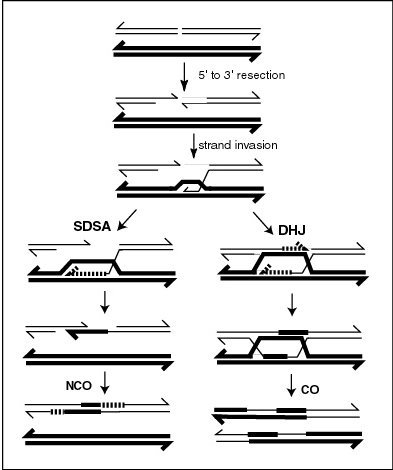Sgs1 on:
[Wikipedia]
[Google]
[Amazon]
Sgs1, also known as slow growth suppressor 1, is a DNA
 The Sgs1( BLM) helicase is an ortholog of the human Bloom syndrome protein. It appears to be a central regulator of most of the recombination events that occur during ''S. cerevisiae''
The Sgs1( BLM) helicase is an ortholog of the human Bloom syndrome protein. It appears to be a central regulator of most of the recombination events that occur during ''S. cerevisiae''
helicase
Helicases are a class of enzymes thought to be vital to all organisms. Their main function is to unpack an organism's genetic material. Helicases are motor proteins that move directionally along a nucleic acid phosphodiester backbone, separat ...
protein found in ''Saccharomyces cerevisiae
''Saccharomyces cerevisiae'' () (brewer's yeast or baker's yeast) is a species of yeast (single-celled fungus microorganisms). The species has been instrumental in winemaking, baking, and brewing since ancient times. It is believed to have been o ...
''. It is a homolog of the bacterial RecQ helicase. Like the other members of the RecQ helicase family, Sgs1 is important for DNA repair
DNA repair is a collection of processes by which a cell identifies and corrects damage to the DNA molecules that encode its genome. In human cells, both normal metabolic activities and environmental factors such as radiation can cause DNA da ...
. In particular, Sgs1 collaborates with other proteins to repair double-strand breaks during homologous recombination
Homologous recombination is a type of genetic recombination in which genetic information is exchanged between two similar or identical molecules of double-stranded or single-stranded nucleic acids (usually DNA as in cellular organisms but may be ...
in eukaryotes.
Meiosis
 The Sgs1( BLM) helicase is an ortholog of the human Bloom syndrome protein. It appears to be a central regulator of most of the recombination events that occur during ''S. cerevisiae''
The Sgs1( BLM) helicase is an ortholog of the human Bloom syndrome protein. It appears to be a central regulator of most of the recombination events that occur during ''S. cerevisiae'' meiosis
Meiosis (; , since it is a reductional division) is a special type of cell division of germ cells in sexually-reproducing organisms that produces the gametes, such as sperm or egg cells. It involves two rounds of division that ultimately ...
. During normal meiosis
Meiosis (; , since it is a reductional division) is a special type of cell division of germ cells in sexually-reproducing organisms that produces the gametes, such as sperm or egg cells. It involves two rounds of division that ultimately ...
Sgs1(BLM) is responsible for directing recombination towards the alternate formation of either early non-crossover recombinants (NCOs) or Holliday junction joint molecules, the latter being subsequently resolved as crossovers (COs) (see Figure). The several roles of Sgs1 in meiotic recombination were reviewed by Klein and Symington. Primarily, Sgs1 displaces the strand invasion intermediate that initiates recombination, thus facilitating NCO recombination (see Homologous recombination
Homologous recombination is a type of genetic recombination in which genetic information is exchanged between two similar or identical molecules of double-stranded or single-stranded nucleic acids (usually DNA as in cellular organisms but may be ...
and Bloom syndrome protein).
Sgs1 also has a role in a pathway leading to CO recombinants. Sgs1 together with EXO1 and MLH1- MLH3 heterodimer (MutL gamma) define a joint molecule resolution pathway that produces the majority of crossovers in budding yeast, and by inference, in mammals.
References
{{Reflist DNA repair